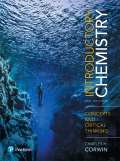
Concept explainers
(a)
Interpretation:
The change in the pressure
Concept introduction:
Boyle’s law which relates pressure and temperature states that when temperature is kept constant for a gas then the pressure and temperature follows the inverse relation. According to Boyle’s law, relation between pressure and volume is written below.
Answer to Problem 11E
The pressure decreases with increase in volume from
Explanation of Solution
According to the equation of Boyle’s law if volume is increased for a particular or constant temperature then the pressure of the gas will be decreased to keep the
Where,
•
•
•
•
•
The given values of the initial volume
Substitute the values of
Therefore, decrease in pressure is
The pressure decreases by the factor of
(b)
Interpretation:
Change in the pressure
Concept introduction:
Gay Lussac’s law one of the
Answer to Problem 11E
The pressure
Explanation of Solution
The relation given by Gay Lussac’s for the gaseous molecule is stated below.
Where,
•
•
•
•
•
Ratio of pressure and temperature is constant. Pressure will be increased with the increase in value of temperature to keep the ratio
Conversion of initial temperature
Conversion of final temperature
Substitute the value of
Therefore, the pressure will increase in the container.
Increase in pressure
(c)
Interpretation:
The change in the pressure
Concept introduction:
Answer to Problem 11E
Increase in pressure
Explanation of Solution
The relation given by all the variables of a gas is stated as below.
According to the relation given above pressure is directly proportional to the number of moles. Pressure will be decreased with the decrease in number of moles to maintain the gas law when all other variables are kept constant.
Gas law is written below.
Where,
•
•
•
•
•
•
•
The number of moles,
The number of moles,
Substitute the given values of
Therefore, the pressure will increase in the container.
The pressure will increase in the container.
Want to see more full solutions like this?
Chapter 10 Solutions
EBK INTRODUCTORY CHEMISTRY
- Liquid oxygen was first prepared by heating potassium chlorate, KClO3, in a closed vessel to obtain oxygen at high pressure. The oxygen was cooled until it liquefied. 2KClO3(s)2KCl(s)+3O2(g) If 171 g of potassium chlorate reacts in a 2.70-L vessel, which was initially evacuated, what pressure of oxygen will be attained when the temperature is finally cooled to 25C? Use the preceding chemical equation and ignore the volume of solid product.arrow_forwardAs 1 g of (lie radioactive element radium decays over 1 year. k produces 1.161018 alpha particles (helium nuclei). Each alpha particle becomes an atom of helium gas. What is the pressure ¡n pascal of the helium gas produced if it occupies a volume of 125 mL at a temperature of 25 C?arrow_forwardA typical barometric pressure in Kansas City is 740 torr. What is this pressure in atmospheres, in millimeters of mercury, and in kilopascals?arrow_forward
 Chemistry: Principles and PracticeChemistryISBN:9780534420123Author:Daniel L. Reger, Scott R. Goode, David W. Ball, Edward MercerPublisher:Cengage Learning
Chemistry: Principles and PracticeChemistryISBN:9780534420123Author:Daniel L. Reger, Scott R. Goode, David W. Ball, Edward MercerPublisher:Cengage Learning Principles of Modern ChemistryChemistryISBN:9781305079113Author:David W. Oxtoby, H. Pat Gillis, Laurie J. ButlerPublisher:Cengage Learning
Principles of Modern ChemistryChemistryISBN:9781305079113Author:David W. Oxtoby, H. Pat Gillis, Laurie J. ButlerPublisher:Cengage Learning General, Organic, and Biological ChemistryChemistryISBN:9781285853918Author:H. Stephen StokerPublisher:Cengage Learning
General, Organic, and Biological ChemistryChemistryISBN:9781285853918Author:H. Stephen StokerPublisher:Cengage Learning General Chemistry - Standalone book (MindTap Cour...ChemistryISBN:9781305580343Author:Steven D. Gammon, Ebbing, Darrell Ebbing, Steven D., Darrell; Gammon, Darrell Ebbing; Steven D. Gammon, Darrell D.; Gammon, Ebbing; Steven D. Gammon; DarrellPublisher:Cengage Learning
General Chemistry - Standalone book (MindTap Cour...ChemistryISBN:9781305580343Author:Steven D. Gammon, Ebbing, Darrell Ebbing, Steven D., Darrell; Gammon, Darrell Ebbing; Steven D. Gammon, Darrell D.; Gammon, Ebbing; Steven D. Gammon; DarrellPublisher:Cengage Learning Chemistry for Today: General, Organic, and Bioche...ChemistryISBN:9781305960060Author:Spencer L. Seager, Michael R. Slabaugh, Maren S. HansenPublisher:Cengage Learning
Chemistry for Today: General, Organic, and Bioche...ChemistryISBN:9781305960060Author:Spencer L. Seager, Michael R. Slabaugh, Maren S. HansenPublisher:Cengage Learning





